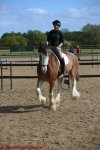abbijay
Well-Known Member
I need to have a little unload away from real life and hopefully draw on experiences of others. Apologies if this is long and rambly, my head is not in the game right now.
My horse is 16 and a large, purebred clydesdale who until recently was happily doing dressage (out at Novice, training almost at Medium at home) and hacking.
There's a lot of back story to this but let's skip to yesterday; vet came to review the forelimb lameness that wasn't responding to bute and we now believe he has done his DDFT. It didn't fully clear on the first nerve block but pretty well cleared up on the second one (fetlock), we x-rayed to have a look and it has confirmed the suspected arthritis in both pastern and coffin joints and the angle of the joints shows it's not fully supported.
MRI is not an option - he is too big.
The vet has put him on 8 weeks of box rest with bute and will come to reassess. We are not looking at him ever doing a dressage test again, if we are lucky he will be a light hack but the vet is suggesting he will need to remain on bute even for this. His expectation is after 8 weeks we will be able to start limited exercise but I think that will be in conjuction with another 8 weeks or so of box rest (and that's assuming all this goes well).
Do people have any positive stories of similar situations? Am I putting him through months of purgatory for, ultimately, next to no quality of life? This horse owes me nothing and I owe him everything so I am desperate to do my best by him.
And just because I wasn't stressed enough as it is he is now deciding that box rest is not good for his guts and I've got the yard on poo watch - he's managing to wait 7-8 hours between poos! (I have spoken to the vet and we are monitoring).
 Picture just because I'll never get to canter him again and I'm so proud of how far he got.
Picture just because I'll never get to canter him again and I'm so proud of how far he got.
My horse is 16 and a large, purebred clydesdale who until recently was happily doing dressage (out at Novice, training almost at Medium at home) and hacking.
There's a lot of back story to this but let's skip to yesterday; vet came to review the forelimb lameness that wasn't responding to bute and we now believe he has done his DDFT. It didn't fully clear on the first nerve block but pretty well cleared up on the second one (fetlock), we x-rayed to have a look and it has confirmed the suspected arthritis in both pastern and coffin joints and the angle of the joints shows it's not fully supported.
MRI is not an option - he is too big.
The vet has put him on 8 weeks of box rest with bute and will come to reassess. We are not looking at him ever doing a dressage test again, if we are lucky he will be a light hack but the vet is suggesting he will need to remain on bute even for this. His expectation is after 8 weeks we will be able to start limited exercise but I think that will be in conjuction with another 8 weeks or so of box rest (and that's assuming all this goes well).
Do people have any positive stories of similar situations? Am I putting him through months of purgatory for, ultimately, next to no quality of life? This horse owes me nothing and I owe him everything so I am desperate to do my best by him.
And just because I wasn't stressed enough as it is he is now deciding that box rest is not good for his guts and I've got the yard on poo watch - he's managing to wait 7-8 hours between poos! (I have spoken to the vet and we are monitoring).
 Picture just because I'll never get to canter him again and I'm so proud of how far he got.
Picture just because I'll never get to canter him again and I'm so proud of how far he got.